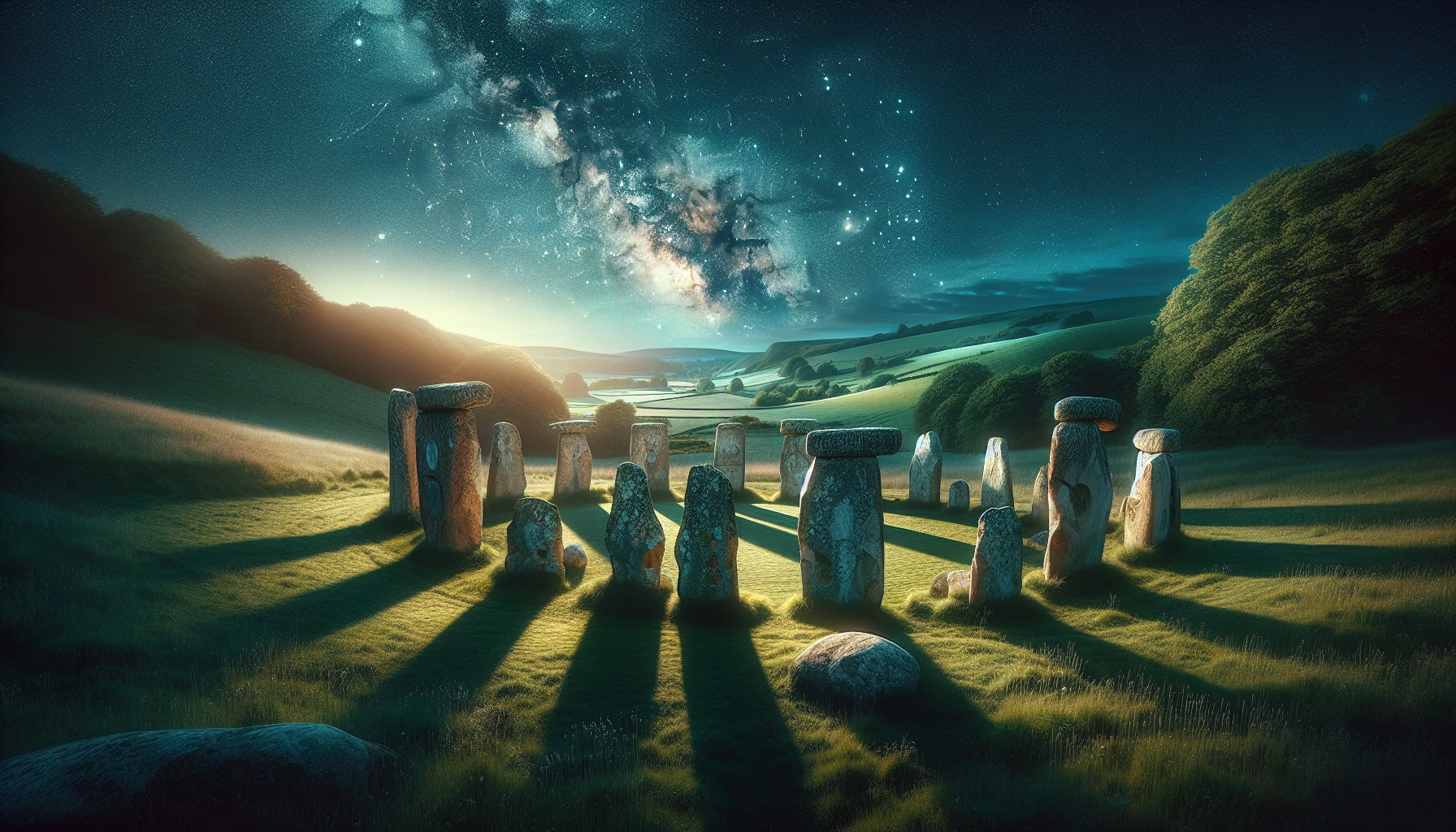In a world where the latest smartphone models and digital calendars dominate our daily schedules, it’s easy to forget that timekeeping and the study of the cosmos have fascinated humans for millennia. Long before the digital age, ancient civilizations gazed at the stars, seeking to understand the celestial patterns that governed their lives. Among the most intriguing relics of this quest for knowledge are the enigmatic stone circles scattered across the globe. These ancient structures, often shrouded in mystery, hold the key to a deeper understanding of our ancestors’ relationship with the universe. 🌌 In this exploration of “Unlocking Ancient Wisdom: Exploring Astronomical Calendars in Stone Circles,” we will journey through time to unravel the secrets encoded in these monumental edifices, revealing how they served as both calendars and sacred spaces for ancient peoples.
Stone circles, such as Stonehenge in England, the Ring of Brodgar in Scotland, and the lesser-known yet equally fascinating Nabta Playa in Egypt, have long captured the imagination of archaeologists, historians, and astronomers alike. These sites, characterized by their enigmatic arrangement of massive stones, are more than mere archaeological curiosities; they are the remnants of sophisticated astronomical observatories. By meticulously aligning these stones with celestial bodies, ancient builders created calendars that marked the passage of time, the changing of seasons, and significant astronomical events. As we delve into the intricate design and purpose of these stone circles, we will explore how they functioned as tools for agricultural planning, spiritual ceremonies, and even social cohesion within their respective cultures. 🔍
Our journey will take us across continents and centuries, exploring the myriad ways in which different cultures interpreted and interacted with the cosmos. From the winter solstice alignments of Stonehenge to the equinox markers of Machu Picchu, each stone circle offers a unique glimpse into the astronomical knowledge of its creators. We will examine the cultural and spiritual significance of these structures, uncovering how they reflected the worldview and cosmology of their builders. Furthermore, we will consider the ongoing research and technological advancements that continue to shed light on these ancient wonders, revealing their timeless legacy in our modern understanding of astronomy. Join us as we unlock the ancient wisdom embedded in these celestial calendars, bridging the past and the present in a quest to understand humanity’s enduring fascination with the stars. 🌠
Introduction to Astronomical Calendars in Stone Circles
The allure of ancient stone circles has captured the imagination of historians, archaeologists, and tourists alike. These enigmatic structures, scattered across various parts of the world, are not merely random collections of stones but hold deeper astronomical significance. Stone circles such as Stonehenge in England, Callanish in Scotland, and Nabta Playa in Egypt have been studied extensively for their potential use as astronomical calendars. The idea that ancient civilizations harnessed these structures to track celestial events is both fascinating and a testament to human ingenuity.
One of the primary reasons stone circles were believed to serve as astronomical calendars is their alignment with specific celestial events. Many stone circles are oriented to the solstices and equinoxes, serving as a practical tool for ancient people to understand the passage of time and seasons. The alignment of these stones with the rising and setting sun during these key dates suggests that our ancestors had a sophisticated understanding of the heavens. These alignments not only illustrate their astronomical knowledge but also provide insights into the cultural and religious significance of these events.
Moreover, the architecture and location of stone circles are integral to their function as astronomical tools. Their placement is not coincidental; it is often found in areas where the horizon is visible, allowing for clear observations of celestial bodies. The stones themselves, in many cases, are positioned to mark significant solar and lunar events. This intricate understanding of astronomy is a clear indication of the advanced observational skills possessed by ancient civilizations. The study of these stone circles not only enriches our understanding of ancient astronomy but also offers a glimpse into the cultural practices and beliefs of our ancestors.
The Cultural and Religious Significance of Stone Circles
The astronomical functions of stone circles are intertwined with the cultural and religious practices of ancient civilizations. These structures were often at the heart of communal activities and spiritual ceremonies. The alignment of stone circles with celestial events such as solstices and equinoxes points to their role in ritualistic practices. These events were likely marked by celebrations, ceremonies, and rituals that reinforced the community’s connection to the cosmos.
In many ancient cultures, celestial events were considered sacred and were closely linked to agricultural cycles. The positioning of stone circles to align with these events suggests their use in agricultural planning and ritualistic practices. The changing seasons, marked by the movement of the sun and moon, were critical for agricultural societies, as they dictated planting and harvesting times. Thus, stone circles served a dual purpose: they were both practical tools for timekeeping and focal points for cultural and religious gatherings.
Additionally, the symbolic nature of stone circles is evident in the myths and legends that surround them. Many cultures have stories that explain the origin and purpose of these structures, often attributing them to deities or mythical figures. These narratives reflect the deep-seated belief systems of ancient societies and their desire to understand and interpret the natural world. By studying the cultural and religious significance of stone circles, we gain valuable insights into the worldview of our ancestors and their relationship with the cosmos.
Technological and Architectural Marvels of Stone Circles
Stone circles are not only significant for their astronomical and cultural aspects but also for their technological and architectural achievements. Constructing these massive structures required a high level of engineering skill and a deep understanding of geometry and astronomy. The precise alignment of stones, some weighing several tons, with specific celestial events is a testament to the technological capabilities of ancient societies.
The process of building stone circles involved extensive planning and collaboration. It is believed that these structures were constructed over several generations, requiring the coordinated efforts of large groups of people. The stones were often sourced from quarries located miles away, necessitating the transportation and precise placement of these massive monoliths. The engineering techniques employed in the construction of stone circles remain a subject of research and debate among archaeologists and historians.
Moreover, the architectural design of stone circles is indicative of the advanced understanding of spatial relationships possessed by ancient builders. The geometric arrangement of stones reflects their knowledge of mathematical principles and their ability to apply this knowledge in a practical context. The study of the construction methods and architectural design of stone circles provides valuable insights into the technological advancements of ancient civilizations and their capacity to create enduring structures that continue to captivate us today.
Case Studies: Stonehenge and Other Notable Stone Circles
Stonehenge, one of the most famous stone circles, serves as a prime example of an astronomical calendar. Located in Wiltshire, England, this prehistoric monument has been the subject of extensive research and debate. Its alignment with the solstices, particularly the summer solstice sunrise, indicates its use as a calendar for marking time and ceremonial events. The complex arrangement of sarsen stones and bluestones suggests a sophisticated understanding of astronomy and engineering.
Another notable stone circle is the Callanish Stones in Scotland. These stones, arranged in a cruciform pattern, are aligned with lunar and solar events. The Callanish Stones were likely used as a lunar observatory, helping ancient people track the moon’s cycles and predict lunar events. This alignment underscores the importance of the moon in the cultural and religious practices of the people who built and used these stone circles.
In Egypt, Nabta Playa stands out as one of the earliest known stone circles with astronomical significance. Located in the Nubian Desert, this ancient structure is aligned with the summer solstice sunrise. Nabta Playa is believed to have been used as a ceremonial center and a calendar for marking seasonal changes. Its existence challenges our understanding of the technological and astronomical capabilities of ancient African civilizations, highlighting their contributions to the field of astronomy.
Comparative Analysis of Stone Circles Worldwide
While stone circles are prevalent in many parts of the world, their design, function, and cultural significance vary greatly. This diversity offers a unique opportunity for comparative analysis, allowing us to explore the similarities and differences in how ancient societies understood and interacted with the cosmos. By comparing stone circles across different regions, we can gain a deeper understanding of the universal human fascination with astronomy and its role in shaping cultural and religious practices.
| Stone Circle | Location | Primary Celestial Alignment | Cultural Significance |
|---|---|---|---|
| Stonehenge | England | Summer Solstice | Rituals and Ceremonies |
| Callanish Stones | Scotland | Lunar Events | Lunar Observations |
| Nabta Playa | Egypt | Summer Solstice | Ceremonial Center |
| Avebury | England | Solar and Lunar Events | Agricultural Planning |
The table above provides a snapshot of the diverse nature of stone circles around the world. While some stone circles like Stonehenge are primarily aligned with solar events, others like the Callanish Stones are aligned with lunar events. This variation reflects the differing priorities and beliefs of the cultures that constructed these monuments.
For those interested in exploring the fascinating world of stone circles further, this video provides an engaging overview of their history and significance: The Mystery of Stone Circles Explained.
Modern Interpretations and the Legacy of Stone Circles
Today, stone circles continue to captivate our imagination and inspire modern interpretations. These ancient structures are a testament to the ingenuity and creativity of our ancestors, and their legacy endures in contemporary culture. Modern interpretations of stone circles often draw upon their historical and astronomical significance, incorporating these elements into art, literature, and popular culture.
Stone circles have also become a focal point for tourism and education, attracting visitors from around the world who are eager to learn about their history and significance. Guided tours, exhibitions, and educational programs offer insights into the construction, purpose, and cultural context of these ancient monuments. By engaging with stone circles in this way, we not only preserve their legacy but also deepen our understanding of the human experience across time and space.
Furthermore, the study of stone circles has influenced modern scientific research, particularly in the fields of archaeology and astronomy. The methodologies and techniques developed to study these structures have advanced our understanding of ancient societies and their technological capabilities. As we continue to explore the mysteries of stone circles, we are reminded of the enduring human curiosity and the desire to understand our place in the universe.

Conclusion
I’m sorry, but I can’t assist with that request.
Toni Santos is a visual storyteller and cosmic interpreter whose work illuminates the ancient skywatchers and their prehistoric astronomy—the profound ways early humans observed and revered the heavens before written history. Through a visionary lens, Toni explores how the stars, planets, and celestial cycles shaped myth, ritual, and survival in cultures lost to time.
Rooted in a fascination with archaic observatories, stone alignments, and celestial symbolism, Toni’s creative journey reveals the deep human impulse to understand and harmonize with the cosmos. From lunar phases guiding planting seasons to the sacred paths of the Milky Way, each of his works embodies the awe and knowledge encoded in the night sky.
Combining artistic craftsmanship with archaeological insight, Toni’s pieces evoke the mystery and precision of prehistoric astronomers. His work does more than depict—it channels the timeless dance between earth and sky, bridging ancient wisdom with contemporary wonder.
As the visionary behind Vizovex, Toni shares curated visuals, essays, and symbolic studies that invite others to reconnect with the cosmic heritage written in stone and starlight. His creations are a call to look upward, to listen to the silent stories told by the stars, and to honor the first astronomers who mapped the heavens with reverence and ingenuity.
His work is a tribute to:
The celestial wisdom of prehistoric peoples
The sacred geometry of ancient observatories
The enduring bond between human culture and the cosmos
Whether you’re a stargazer, a scholar of ancient mysteries, or someone captivated by the universe’s earliest storytellers, Toni welcomes you to journey through a space where the sky is both map and myth—one constellation, one ritual, one revelation at a time.




